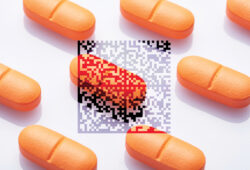Amid the gloom, discoveries have emerged
The pandemic and its impact have likely been well beyond what many of us could have imagined a year ago—hundreds of thousands of Americans dying, millions suffering symptoms and many losing their jobs—not to mention an increase in suicide rates and overwhelmed hospitals. Yet through this darkness, silver linings have emerged.

HealthTrust Physician Advisor S. Shaefer Spires, M.D., is an infectious disease specialist and assistant professor of medicine at Duke University School of Medicine. As Medical Director of Duke’s Antimicrobial Stewardship Outreach Network, Dr. Spires works with 34 community hospitals advising on antibiotic and vaccine stewardship.
He’s also a self-proclaimed glass-half-full kind of person—even during a pandemic.
Of the progress that COVID-19 has forced, Dr. Spires shares his excitement around the development of COVID-19 vaccines, which, he says, “is probably the biggest scientific achievement to happen in my lifetime.”
The miracle of mRNA
Messenger RNA (mRNA) technology has been studied for more than a decade. As soon as Chinese scientists were able to post the entire genome sequence of the virus in January 2020, vaccine companies Moderna and Pfizer/BioNTech collaborated and used computer modeling to create the parts of the virus that neutralize antibodies. According to the Centers for Disease Control and Prevention (CDC), mRNA vaccines emulate the process that cells use to make proteins that trigger an immune response and build immunity to SARS-CoV-2, the virus that causes COVID-19. With this process, weakened or inactivated virus components are not used as they are in other vaccines.
“This is a remarkable achievement, and it happened in under a year. It rivals, if not supersedes, the achievement of landing on the moon. It’s a miracle, and early outcomes are proving it is highly effective,” says Dr. Spires.
The other exciting part of mRNA technology is that it can be applied to vaccines for other diseases such as influenza and hepatitis B. Scientists can now go backward and create mRNA sequences for those diseases, which could mean potentially more effective vaccines. Currently, the flu vaccine is only about 50% effective in a good year. A large number of chicken eggs are harvested to make the antigen from cell cultures—a logistical supply chain feat each year. With applied mRNA technology, that could change. A limitation, however, is the significant capital needed to make it happen.
A deeper understanding of vaccine science
The highs and lows of the pandemic have turned millions of us into budding epidemiologists. It has brought under the microscope the entire process of how a new medicine comes to fruition, broadening the education of those who don’t practice or study medicine.
“Even in the midst of political discourse, the clinical trial process remained flawless and uninfluenced by politics,” Dr. Spires says. These protocols have been tried and tested for decades, and they were allowed to happen appropriately—and the public got a front seat in learning how safety and efficacy were measured. “More of the public now understands what actually goes on in a study, and which studies are worth listening to,” he adds. “Many people read or hear the numbers and understand them enough to agree or disagree with public health officials. For the first time, more of the population understands what efficacy means. As an infectious disease physician, it’s fun for me to see lights go off in people’s minds as they get it.”
A more transparent process
On Jan. 31, 2020, the U.S. Secretary of Health and Human Services Alex Azar declared a public health emergency in order to aid in the nation’s healthcare community response to COVID-19. This measure paved the way for the Food and Drug Administration (FDA) to issue emergency use authorizations to provide more timely access to drugs, tests and products since adequate treatment wasn’t available, and we couldn’t afford to wait for the usual drug-vetting process.

“The CDC, FDA and professional societies had to become much more transparent to the public in terms of sharing data, tools and processes, which has been extremely valuable,” says Angie Mitchell, RN, former AVP of Clinical Services at HealthTrust. Like many of her colleagues, Mitchell’s role during the pandemic expanded. Her expertise was triaged to COVID workstreams, which evaluated and supported alternative clinical care approaches as well as vetted global and domestic-based potential suppliers with COVID-related products.
Aligning vaccine protocols at record speed
“Operation Warp Speed is a tremendous logistical achievement in and of itself,” says Dr. Spires. “It will go down in history as something that’s never been done before.”
The federal government invested billions of dollars to support vaccine and therapeutic development. Safety and efficacy protocols were aligned and overseen by the government, and steps in the process were allowed to happen simultaneously, including mass-producing a vaccine candidate while completing safety and efficacy testing. This meant that there was high financial risk, but no product risk. These actions have led to great collaboration among the public and private sectors.
Data from Pfizer and Moderna was published in a peer-reviewed journal and on the FDA website, so anyone could access it. Because the process was so transparent, medical experts can confidently recommend the vaccines.
Enhanced communication technology
People across the country followed government orders and state and local health officials’ advice to limit going to public places, avoid large gatherings, wear masks and socially distance to reduce virus exposure. Going to healthcare facilities became a feared prospect, but many people still needed important medical care during the pandemic. Video communication technologies like Zoom and FaceTime became lifelines for healthcare organizations to continue caring for patients.
While telemedicine is not appropriate for all patient encounters and may not take the place of an in-person assessment in some instances, it has proven effective for chronic disease management for conditions such as diabetes and asthma—and has allowed many patients to get the care they need from the safety of their homes.
Innovation at every turn

Karen Bush, MSN, FNP, BC, NCRP, Director of Clinical Research & Education at HealthTrust, has spent the pandemic leading the team that developed clinical resources for members and the general public, linking them to critical information. “Throughout this pandemic, on national, regional and local levels, the private and public sectors and healthcare all worked together to try to solve the problem of the moment, whatever it was,” says Bush. “It made me really proud.”
Innovation has happened on all levels of patient care. “I’ve been a clinician for a long time,” says Mitchell. “I grew up with the belief that if you give a nurse a book of matches and a roll of duct tape, he or she will build what you need.” Following the guiding principle to first, do no harm, healthcare professionals transformed and reinvented in order to get the job done.
We aren’t out of the storm yet; COVID-19 continues to be a public health crisis. But with promising vaccines, new ways of communicating and a renewed solidarity among healthcare sectors, there are bright lights of hope shining through the clouds.
Share Email COVID-19, FDA Updates, Q2 2021, Vaccines




